Exploring the Use of Data in a Digital Twin for the Marine and Coastal Environment
Abstract
:1. Introduction
2. Data in a Digital Twin of the Ocean (DTO)
2.1. In Situ Measurements of the Ocean
2.2. Satellite Remote Sensing
2.3. Modelled and Existing Training Data
2.4. Ancillary Datasets
2.5. Summary of Various Data Sources
3. Data Management in a Digital Twin of the Ocean
3.1. Current Data Management Practises for Digital Twins
3.1.1. Data Collection and Acquisition
3.1.2. Data Storage
3.1.3. Data Integration
3.1.4. Data Access and Retrieval
3.2. Data Management in the Digital Twin of the Southern African and Western Indian Ocean Region
3.3. Data Life Cycle
4. Data Management Plan
4.1. Principle 1: Conceptualisation
4.2. Principle 2: Identify Data to Be Collected
4.3. Principle 3: Organisation of Data
4.4. Principle 4: Documentation of Data Descriptions
4.5. Principle 5: Data Quality Assurance
4.6. Principle 6: Data Storage and Preservation of Statergy
4.7. Principle 7: Data Policies and Governance
4.8. Principle 8: Description of Data Dissemination
4.9. Principle 9: Management of Roles and Responbsibilities
5. Challenges of Data Management in a Digital Twin of the Ocean
6. Conclusions
Author Contributions
Funding
Data Availability Statement
Conflicts of Interest
References
- Amani, M.; Moghimi, A.; Mirmazloumi, S.M.; Ranjgar, B.; Ghorbanian, A.; Ojaghi, S.; Ebrahimy, H.; Naboureh, A.; Nazari, M.E.; Mahdavi, S.; et al. Ocean Remote Sensing Techniques and Applications: A Review (Part I). Water 2022, 14, 3400. [Google Scholar] [CrossRef]
- Costanza, R. The ecological, economic and social importance of the oceans. Ecol. Econ. 1999, 31, 199–213. [Google Scholar]
- Tzachor, A.; Hendel, O.; Richards, C.E. Digital twins: A stepping stone to achieve ocean sustainability? npj Ocean Sustain. 2023, 2, 16. [Google Scholar] [CrossRef]
- Lv, Z.; Lv, H.; Fridenfalk, M. Digital Twins in the Marine Industry. Electronics 2023, 12, 2025. [Google Scholar] [CrossRef]
- Teh, L.C.L.; Sumaila, U.R. Contribution of marine fisheries to worldwide employment. Fish Fish. 2013, 14, 77–88. [Google Scholar] [CrossRef]
- Ritchie, H.; Samborska, V.; Roser, M. Plastic Pollution. Available online: https://ourworldindata.org/plastic-pollution (accessed on 3 November 2024).
- Mills, G.; Fones, G. A review of in situ/IT methods and sensors for monitoring the marine environment. Sens. Rev. 2012, 32, 17–28. [Google Scholar] [CrossRef]
- Miedtank, A.; Schneider, J.; Manss, C.; Zielinski, O. Marine digital twins for enhanced ocean understanding. Remote Sens. Appl. Soc. Environ. 2024, 36, 101268. [Google Scholar] [CrossRef]
- Chen, G.; Yang, J.; Huang, B.; Ma, C.; Tian, F.; Ge, L.; Xia, L.; Li, J. Toward digital twin of the ocean: From digitalization to cloning. Intell. Mar. Technol. Syst. 2023, 1, 3. [Google Scholar] [CrossRef]
- Zhang, M.; Tao, F.; Huang, B.; Liu, A.; Wang, L.; Anwer, N.; Nee, A.Y.C. Digital twin data: Methods and key technologies. Digit. Twin 2022, 1, 2. [Google Scholar] [CrossRef]
- Liu, M.; Fang, S.; Dong, H.; Xu, C. Review of digital twin about concepts, technologies, and industrial applications. J. Manuf. Syst. 2021, 58, 346–361. [Google Scholar] [CrossRef]
- Grieves, M. Digital Twin: Manufacturing Excellence through Virtual Factory Replication. White Paper 2014, 1, 1–7. [Google Scholar]
- Bahurel, P.; Brönner, U.; Buttigieg, P.-L.; Chai, F.; Chassignet, E.; Devey, C.; Fanjul, E.A.; Hill, K.; Kim, S.Y.; Kollert, J.; et al. DITTO Programme White Paper. Available online: https://ditto-oceandecade.org/wp-content/uploads/2023/07/DITTO-Whitepaper_FINAL-July-2023.pdf (accessed on 3 October 2024).
- Berre, A.J.; Pearlman, J.; Bye, B.; Masó, J.; Digital, S. Iliad Digital Twins of the Ocean Interoperability Architecture. In Proceedings of the IGARSS, Athens, Greece, 7–12 July 2024; pp. 3568–3571. [Google Scholar]
- Yu, Z.; Du, P.; Yi, L.; Luo, W.; Li, D.; Zhao, B.; Li, L.; Zhang, Z.; Zhang, J.; Zhang, J.; et al. Coastal Zone Information Model: A comprehensive architecture for coastal digital twin by integrating data, models, and knowledge. Fundam. Res. 2024. [Google Scholar] [CrossRef]
- Spanoudaki, K.; Kozyrakis, G.; Metheniti, V.; Parasyris, A.; Kampanis, N. The Cretan Sea oil spill Digital Twin pilot for the ILIAD Digital Twin of the Ocean. In Proceedings of the Cretan Sea Oil Spill Digital Twin Pilot for the ILIAD Digital Twin of the Ocean, EGU General Assembly, Vienna, Austria, 23–28 April 2023. [Google Scholar]
- Brönner, U.; Sonnewald, M.; Visbeck, M. Digital Twins of the Ocean can foster a sustainable blue economy in a protected marine environment. Int. Hydrogr. Rev. 2023, 29, 26–40. [Google Scholar] [CrossRef]
- Tao, F.; Zhang, M. Digital Twin Shop-Floor: A New Shop-Floor Paradigm Towards Smart Manufacturing. IEEE Access 2017, 5, 10. [Google Scholar]
- Singh, S.; Shehab, E.; Higgins, N.; Fowler, K.; Reynolds, D.; Erkoyuncu, J.A.; Gadd, P. Data management for developing digital twin ontology model. Proc. Inst. Mech. Eng. Part B J. Eng. Manuf. 2021, 235, 2323–2337. [Google Scholar] [CrossRef]
- Dihan, M.S.; Akash, A.I.; Tasneem, Z.; Das, P.; Das, S.K.; Islam, M.R.; Islam, M.M.; Badal, F.R.; Ali, M.F.; Ahamed, M.H.; et al. Digital twin: Data exploration, architecture, implementation and future. Heliyon 2024, 10, e26503. [Google Scholar] [CrossRef]
- Liu, Y.; Qiu, M.; Liu, C.; Guo, Z. Big data challenges in ocean observation: A survey. Pers. Ubiquitous Comput. 2017, 21, 55–65. [Google Scholar] [CrossRef]
- Wu, X.; Lu, G.; Wu, Z. Remote Sensing Technology in the Construction of Digital Twin Basins: Applications and Prospects. Water 2023, 15, 2040. [Google Scholar] [CrossRef]
- Lin, M.; Yang, C. Ocean Observation Technologies: A Review. Chin. J. Mech. Eng. 2020, 33, 32. [Google Scholar] [CrossRef]
- Nakath, D.; She, M.; Song, Y.; Köser, K. An Optical Digital Twin for Underwater Photogrammetry: GEODT—A Geometrically Verified Optical Digital Twin for Development, Evaluation, Training, Testing and Tuning of Multi-Media Refractive Algorithms. PFG—J. Photogramm. Remote Sens. Geoinf. Sci. 2022, 90, 69–81. [Google Scholar] [CrossRef]
- Minnett, P.J.; Alvera-Azcárate, A.; Chin, T.M.; Corlett, G.K.; Gentemann, C.L.; Karagali, I.; Li, X.; Marsouin, A.; Marullo, S.; Maturi, E.; et al. Half a century of satellite remote sensing of sea-surface temperature. Remote Sens. Environ. 2019, 233, 111366. [Google Scholar] [CrossRef]
- Biermann, L.; Clewley, D.; Martinez-Vicente, V.; Topouzelis, K. Finding Plastic Patches in Coastal Waters using Optical Satellite Data. Sci. Rep. 2020, 10, 5364. [Google Scholar] [CrossRef]
- Amani, M.; Mehravar, S.; Asiyabi, R.M.; Moghimi, A.; Ghorbanian, A.; Ahmadi, S.A.; Ebrahimy, H.; Moghaddam, S.H.A.; Naboureh, A.; Ranjgar, B.; et al. Ocean Remote Sensing Techniques and Applications: A Review (Part II). Water 2022, 14, 3401. [Google Scholar] [CrossRef]
- Asiyabi, R.M.; Ghorbanian, A.; Tameh, S.N.; Amani, M.; Jin, S.; Mohammadzadeh, A. Synthetic Aperture Radar (SAR) for Ocean: A Review. IEEE J. Sel. Top. Appl. Earth Obs. Remote Sens. 2023, 16, 9106–9138. [Google Scholar] [CrossRef]
- Saxena, N.; Rathore, N. A review on speckle noise filtering techniques for SAR Images. Int. J. Adv. Res. Comput. Sci. Electron. Eng. 2013, 2, 243–247. [Google Scholar]
- Link, J.S.; Thur, S.; Matlock, G.; Grasso, M. Why we need weather forecast analogues for marine ecosystems. ICES J. Mar. Sci. 2023, 80, 2087–2098. [Google Scholar] [CrossRef]
- Skákala, J.; Awty-Carroll, K.; Menon, P.P.; Wang, K.; Lessin, G. Future digital twins: Emulating a highly complex marine biogeochemical model with machine learning to predict hypoxia. Front. Mar. Sci. 2023, 10, 1058837. [Google Scholar] [CrossRef]
- Ko, D.S.; Martin, P.J.; Rowley, C.D.; Preller, R.H. A real-time coastal ocean prediction experiment for MREA04. J. Mar. Syst. 2008, 69, 17–28. [Google Scholar] [CrossRef]
- Sonnewald, M.; Lguensat, R.; Jones, D.C.; Dueben, P.D.; Brajard, J.; Balaji, V. Bridging observations, theory and numerical simulation of the ocean using machine learning. Environ. Res. Lett. 2021, 16, 073008. [Google Scholar] [CrossRef]
- Burchard, H.; Rennau, H. Comparative quantification of physically and numerically induced mixing in ocean models. Ocean Model. 2008, 20, 293–311. [Google Scholar] [CrossRef]
- Armenio, E.; Ben Meftah, M.; De Padova, D.; De Serio, F.; Mossa, M. Monitoring systems and numerical models to study coastal sites. Sensors 2019, 19, 1552. [Google Scholar] [CrossRef]
- Lellouche, J.M.; Greiner, E.; Le Galloudec, O.; Garric, G.; Regnier, C.; Drevillon, M.; Benkiran, M.; Testut, C.E.; Bourdalle-Badie, R.; Gasparin, F.; et al. Recent updates to the Copernicus Marine Service global ocean monitoring and forecasting real-time 1g 12° high-resolution system. Ocean Sci. 2018, 14, 1093–1126. [Google Scholar] [CrossRef]
- Jonathan, P.; Ewans, K. Statistical modelling of extreme ocean environments for marine design: A review. Ocean Eng. 2013, 62, 91–109. [Google Scholar] [CrossRef]
- Li, X.; Liu, H.; Wang, W.; Zheng, Y.; Lv, H.; Lv, Z. Big data analysis of the Internet of Things in the digital twins of smart city based on deep learning. Future Gener. Comput. Syst. 2022, 128, 167–177. [Google Scholar] [CrossRef]
- Moore, A.M.; Martin, M.J.; Akella, S.; Arango, H.G.; Balmaseda, M.; Bertino, L.; Ciavatta, S.; Cornuelle, B.; Cummings, J.; Frolov, S.; et al. Synthesis of ocean observations using data assimilation for operational, real-time and reanalysis systems: A more complete picture of the state of the ocean. Front. Mar. Sci. 2019, 6, 90. [Google Scholar] [CrossRef]
- Capotondi, A.; Jacox, M.; Bowler, C.; Kavanaugh, M.; Lehodey, P.; Barrie, D.; Brodie, S.; Chaffron, S.; Cheng, W.; Dias, D.F.; et al. Observational Needs Supporting Marine Ecosystems Modeling and Forecasting: From the Global Ocean to Regional and Coastal Systems. Front. Mar. Sci. 2019, 6, 623. [Google Scholar] [CrossRef]
- Abraham, J.P.; Baringer, M.; Bindoff, N.L.; Boyer, T.; Cheng, L.J.; Church, J.A.; Conroy, J.L.; Domingues, C.M.; Fasullo, J.T.; Gilson, J.; et al. A review of global ocean temperature observations: Implications for ocean heat content estimates and climate change. Rev. Geophys. 2013, 51, 450–483. [Google Scholar] [CrossRef]
- Arbic, B.K. Incorporating tides and interval gravity waves within global ocean general circulation models: A review. Prog. Oceanogr. 2022, 206, 102824. [Google Scholar] [CrossRef]
- Madec, G.; The NEMO Team. NEMO Ocean Engine Reference Manual. Zenodo 2024. [Google Scholar] [CrossRef]
- Bessières, L.; Leroux, S.; Brankart, J.M.; Molines, J.M.; Moine, M.P.; Bouttier, P.A.; Penduff, T.; Terray, L.; Barnier, B.; Sérazin, G. Development of a probabilistic ocean modelling system based on NEMO 3.5: Application at eddying resolution. Geosci. Model Dev. 2017, 10, 1091–1106. [Google Scholar] [CrossRef]
- Chassignet, E.P.; Hurlburt, H.E.; Metzger, E.J.; Smedstad, O.M.; Cummings, J.A.; Halliwell, G.R.; Bleck, R.; Baraille, R.; Wallcraft, A.J.; Lozano, C.; et al. Global ocean prediction with the hybrid Coordinate Ocean Model (HYCOM). Oceanography 2009, 22, 64–75. [Google Scholar] [CrossRef]
- Haidvogel, D.B.; Arango, H.; Budgell, W.P.; Cornuelle, B.D.; Curchitser, E.; Di Lorenzo, E.; Fennel, K.; Geyer, W.R.; Hermann, A.J.; Lanerolle, L.; et al. Ocean forecasting in terrain-following coordinates: Formulation and skill assessment of the Regional Ocean Modeling System. J. Comput. Phys. 2008, 227, 3595–3624. [Google Scholar] [CrossRef]
- Danilov, S.; Sidorenko, D.; Wang, Q.; Jung, T. The finite-volume sea ice-Ocean model (FESOM2). Geosci. Model Dev. 2017, 10, 765–789. [Google Scholar] [CrossRef]
- van Dinter, R.; Tekinerdogan, B.; Catal, C. Predictive maintenance using digital twins: A systematic literature review. Inf. Softw. Technol. 2022, 151, 107008. [Google Scholar] [CrossRef]
- Wong, A.P.S.; Wijffels, S.E.; Riser, S.C.; Pouliquen, S.; Hosoda, S.; Roemmich, D.; Gilson, J.; Johnson, G.C.; Martini, K.; Murphy, D.J.; et al. Argo Data 1999–2019: Two Million Temperature-Salinity Profiles and Subsurface Velocity Observations From a Global Array of Profiling Floats. Front. Mar. Sci. 2020, 7, 700. [Google Scholar] [CrossRef]
- Kikaki, K.; Kakogeorgiou, I.; Mikeli, P.; Raitsos, D.E.; Karantzalos, K. MARIDA: A benchmark for Marine Debris detection from Sentinel-2 remote sensing data. PLoS ONE 2022, 17, e0262247. [Google Scholar] [CrossRef]
- Flanders Marine Institute: MarineRegions.org. Available online: www.marineregions.org (accessed on 7 October 2024).
- Huang, S.; Wang, G.; Yan, Y.; Fang, X. Blockchain-based data management for digital twin of product. J. Manuf. Syst. 2020, 54, 361–371. [Google Scholar] [CrossRef]
- Diène, B.; Rodrigues, J.J.P.C.; Diallo, O.; Ndoye, E.H.M.; Korotaev, V.V. Data management techniques for Internet of Things. Mech. Syst. Signal Process. 2020, 138, 106564. [Google Scholar] [CrossRef]
- Corrall, S. Designing libraries for research collaboration in the network world: An exploratory study. Lib. Q. 2014, 24, 17–48. [Google Scholar] [CrossRef]
- Cox, A.M.; Tam, W.W.T. A critical analysis of lifecycle models of the research process and research data management. Aslib J. Inf. Manag. 2018, 70, 142–157. [Google Scholar] [CrossRef]
- Buys, C.M.; Shaw, P.L. Data Management Practices Across an Institution: Survey and Report. J. Librariansh. Sch. Commun. 2015, 3, 1225. [Google Scholar] [CrossRef]
- Reichmann, S.; Klebel, T.; Hasani-Mavriqi, I.; Ross-Hellauer, T. Between administration and research: Understanding data management practices in an institutional context. J. Assoc. Inf. Sci. Technol. 2021, 72, 1415–1431. [Google Scholar] [CrossRef]
- Correia, J.B.; Abel, M.; Becker, K. Data management in digital twins: A systematic literature review. Knowl. Inf. Syst. 2023, 65, 3165–3196. [Google Scholar] [CrossRef]
- Boyes, H.; Watson, T. Digital twins: An analysis framework and open issues. Comput. Ind. 2022, 143, 103763. [Google Scholar] [CrossRef]
- Grossmann, V.; Nakath, D.; Urlaub, M.; Oppelt, N.; Koch, R.; Köser, K. Digital twinning in the ocean-challenges in multimodal sensing and multiscale fusion based on faithful visual models. ISPRS Ann. Photogramm. Remote Sens. Spat. Inf. Sci. 2022, 5, 345–352. [Google Scholar] [CrossRef]
- Michener, W.K. Ten Simple Rules for Creating a Good Data Management Plan. PLoS Comput. Biol. 2015, 11, e1004525. [Google Scholar] [CrossRef]
- Group on Earth Observations (GEO). Revised GEO Data Sharing and Data Management Principles. In Proceedings of the 23rd Programme Board Meeting, Virtual, 21–23 June 2022. [Google Scholar]
- ISO 19157:2023; Geographic Information—Data Quality. ISO: Geneva, Switzerland, 2023. Available online: https://www.iso.org/standard/78900.html (accessed on 19 March 2025).
- ISO/TS 19158:2012; Geographic Information—Quality Assurace of Data Supply. ISO: Geneva, Switzerland, 2012. Available online: https://www.iso.org/standard/32576.html (accessed on 19 March 2025).
- Krug, M.; Naidoo, A.; Williams, L. South Africa’s oceans and coastal and information management system towards improved ocean access, protection, and governance. J. Environ. Manag. 2024, 354, 120255. [Google Scholar] [CrossRef]
- Lee, Y.; Choi, M.H.; Song, Y.S.; Lee, J.G.; Park, J.Y.; Li, K.J. Building an Indoor Digital Twin—A Use-Case for a Hospital Digital Twin to Analyze COVID-19 Transmission. ISPRS Int. J. Geo-Inf. 2024, 13, 460. [Google Scholar] [CrossRef]
- Coetzee, S.; Cooper, A.K.; Rautenbach, V. Part C: Standards for Fundamental Geo-Spatial Datasets. In Guidelines of Best Practice for the Acquisition, Storage, Maintenance and Dissemenation of Fundamental Geo-Spatial Datasets; Clarke, D.G., Ed.; Mapping Africa for Africa (MAfA); United Nations Economic Commission for Africa (UN ECA): Addis Ababa, Ethiopia, 2014; p. 124. [Google Scholar]
- Jacobsen, A.; de Miranda Azevedo, R.; Juty, N.; Batista, D.; Coles, S.; Cornet, R.; Courtot, M.; Crosas, M.; Dumontier, M.; Schultes, E.; et al. FAIR Principles: Interpretations and Implementation Considerations. Data Intell. 2020, 2, 10–29. [Google Scholar] [CrossRef]
- Lin, D.; Crabtree, J.; Dillo, I.; Downs, R.R.; Edmunds, R.; Giaretta, D.; De Giusti, M.; L’Hours, H.; Hugo, W.; Jenkyns, R.; et al. The TRUST Principles for digital repositories. Sci. Data 2020, 7, 144. [Google Scholar] [CrossRef]
- Sibolla, B.; Molapo, R.; Vhengani, L.; Mdakane, L. Systems and Architectural Support for Open Data Principles: A Marine Earth Observation Perspective. Int. Arch. Photogramm. Remote Sens. Spat. Inf. Sci.—ISPRS Arch. 2023, 48, 1005–1012. [Google Scholar] [CrossRef]
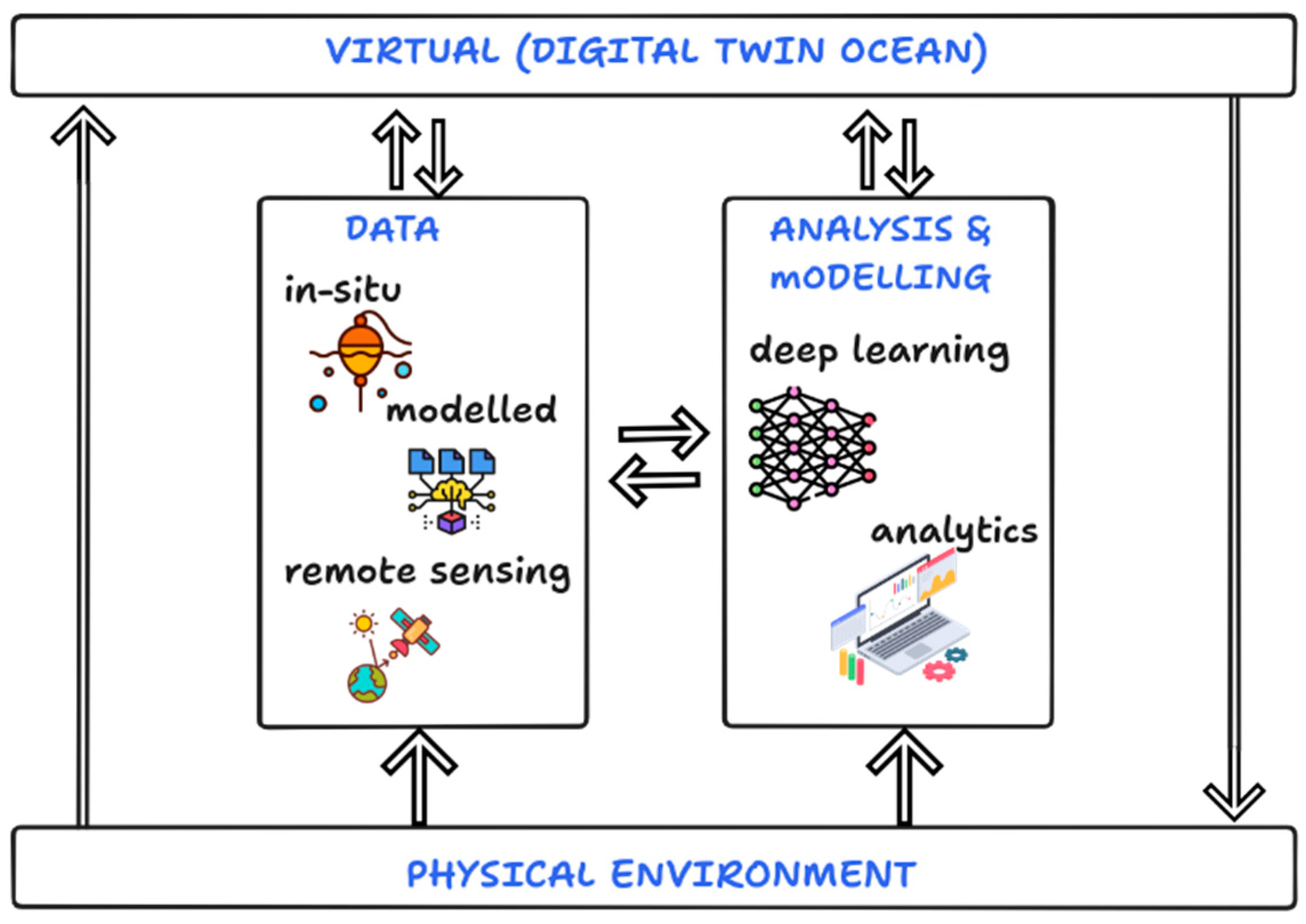
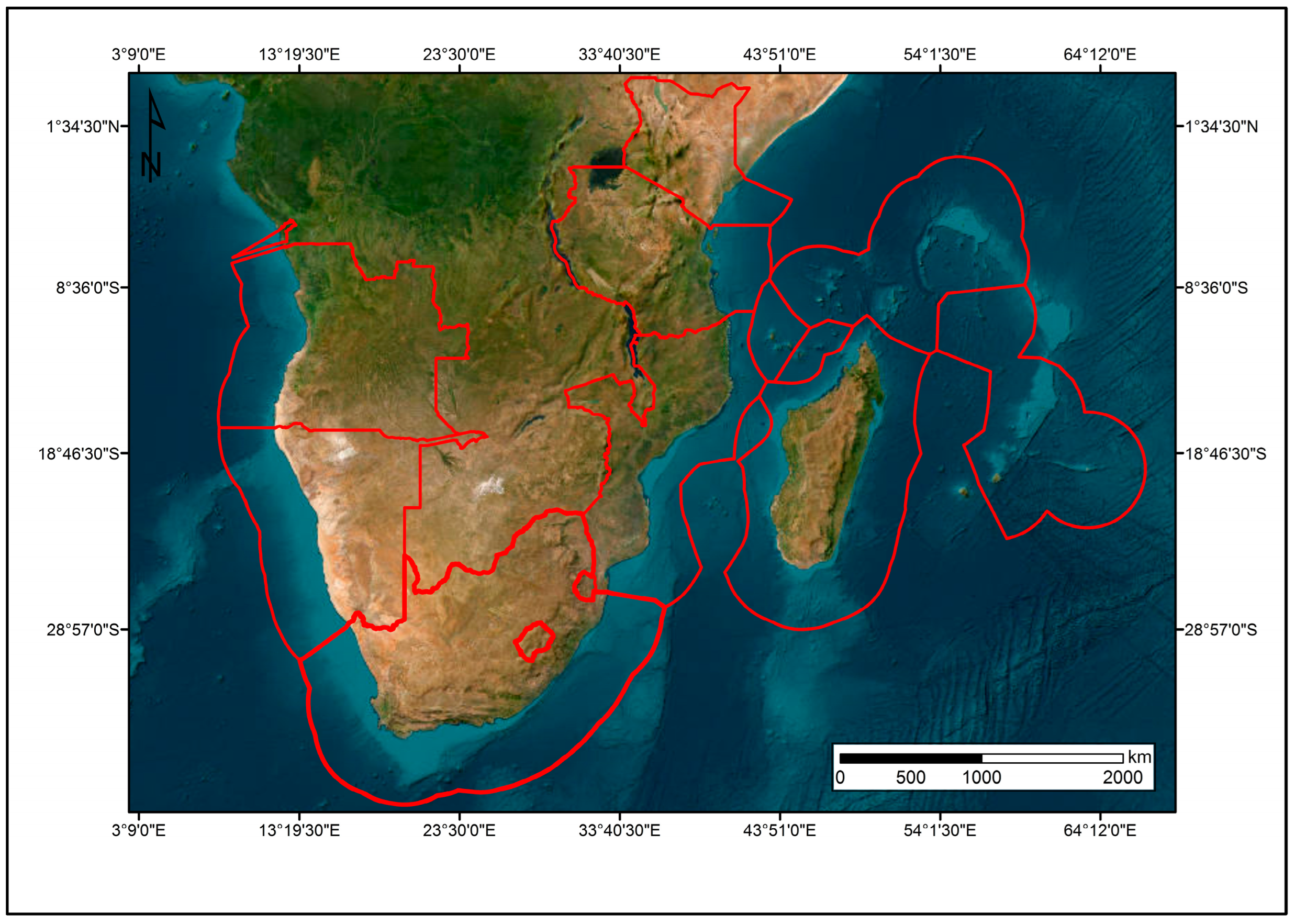
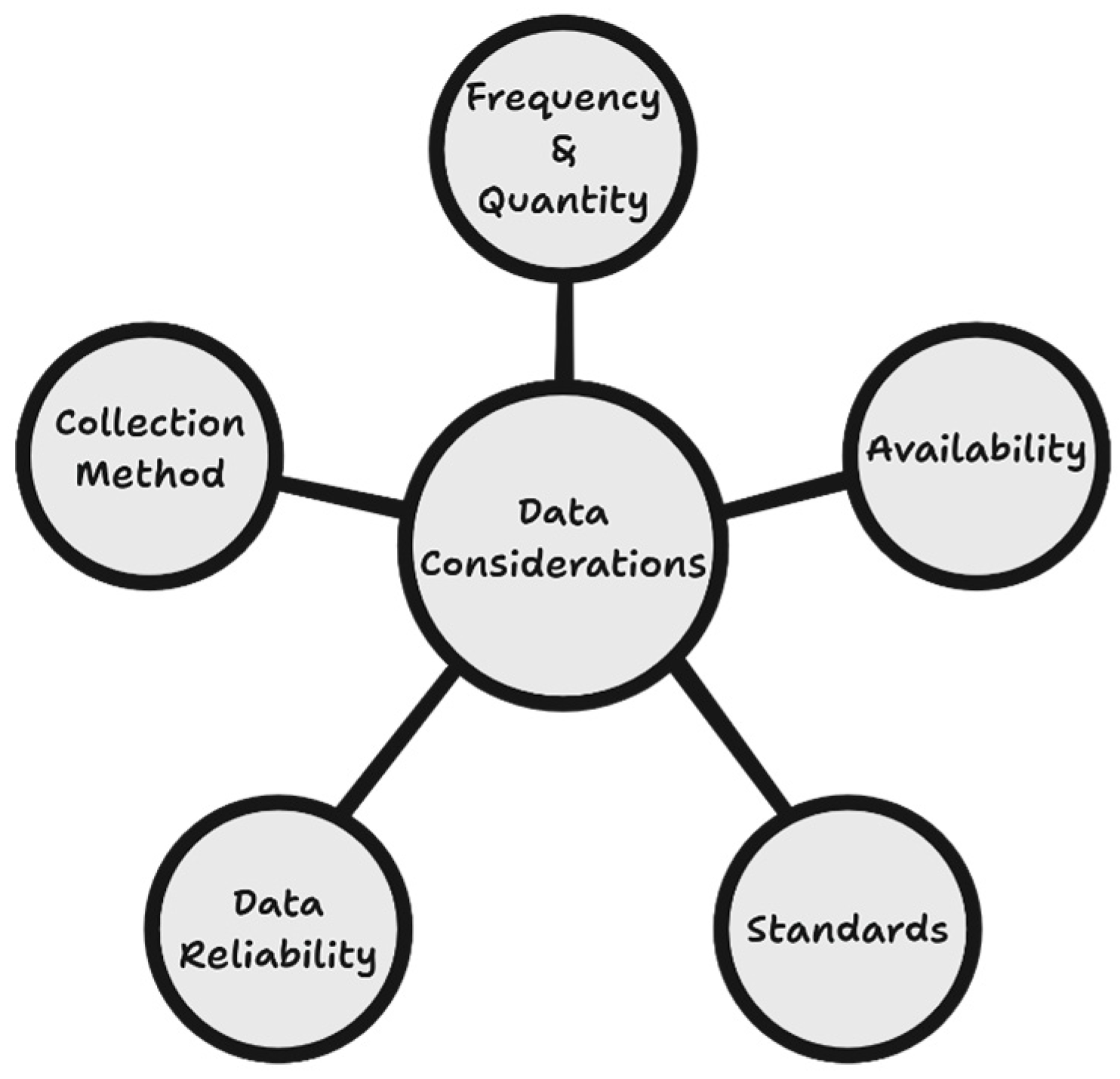
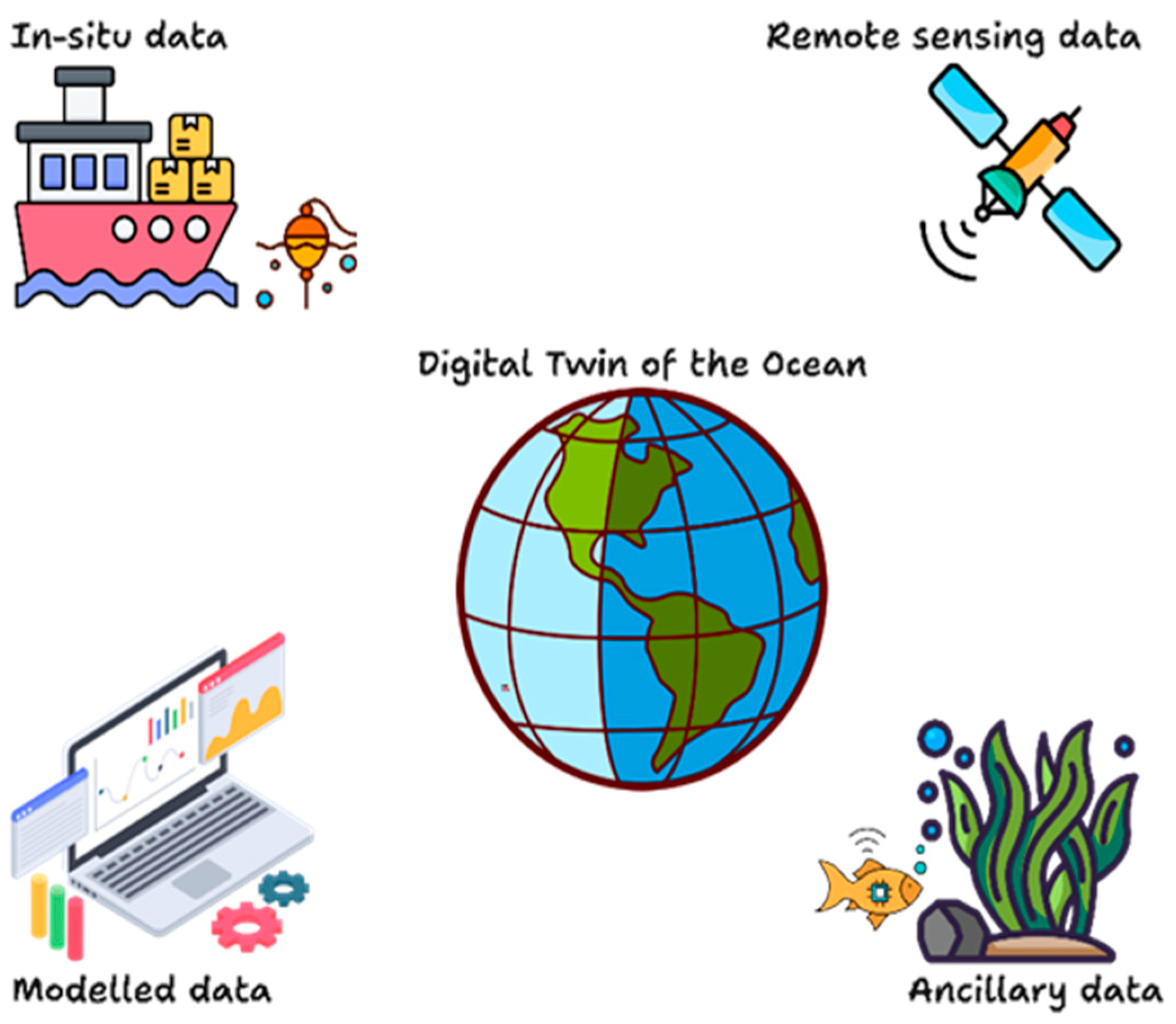

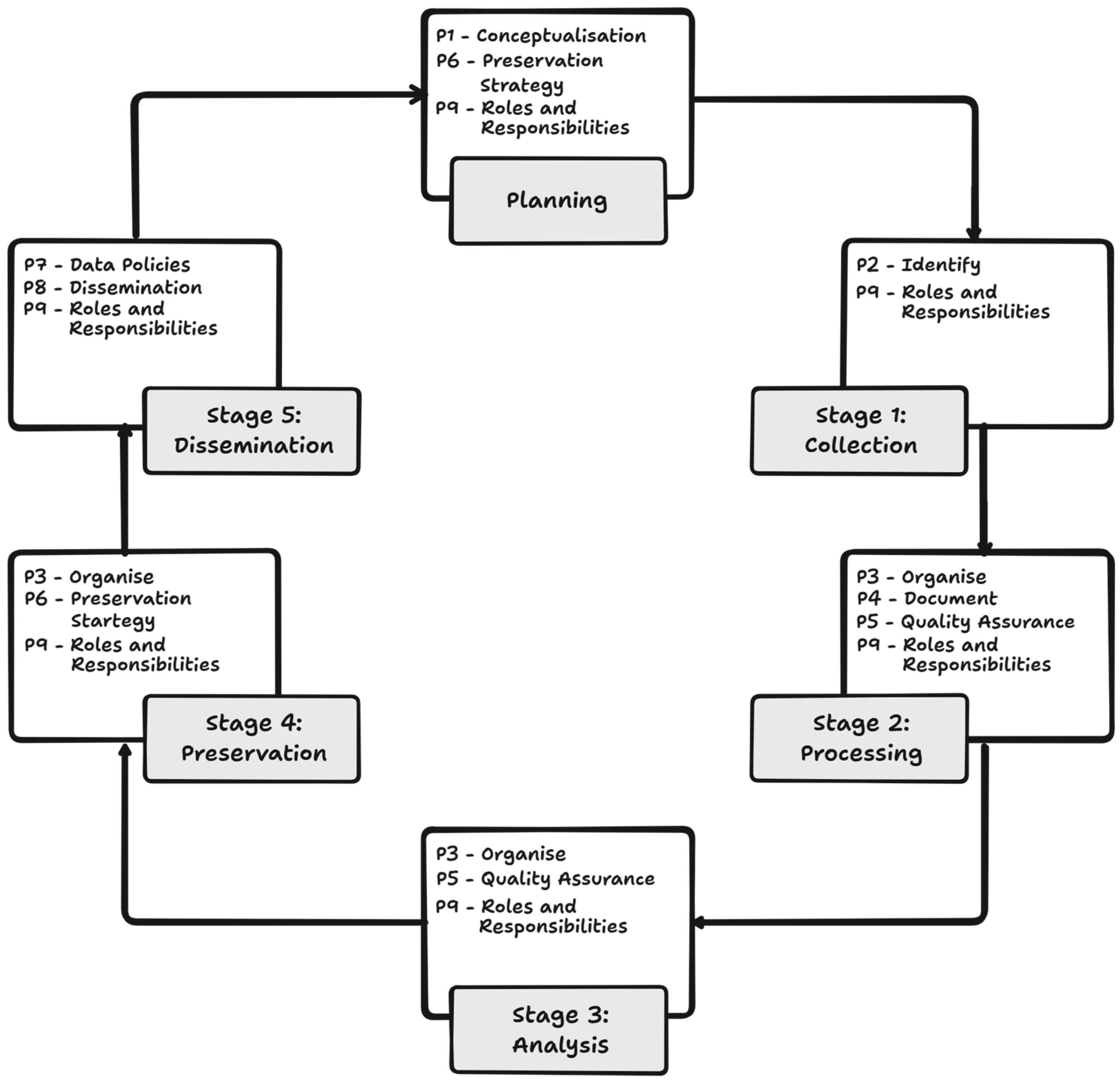
| Ocean Variable | Data Collection Techniques | Frequency | Spatial Scale/Resolution |
|---|---|---|---|
| Sea surface temperature | In situ: surface buoy thermometer; Remote sensing: TIR and microwave radiometers | In situ: hourly/daily Remote sensing: 1 to 8 days | In situ: 1 m to 1 km Remote sensing: 750 m to 1 km |
| Sea salinity | In situ: conductivity temperature depth (CTD) probe/sensors | In situ: hourly/daily | In situ: 1 m to 1 km |
| pH | In situ: electrode | In situ: daily/weekly | In situ: depth of 2 km |
| Pressure | In situ: strain gauge sensor; marine pressure sensors | In situ: daily/weekly | In situ: depth of 7 km |
| Ocean currents and waves | In situ: acoustic Doppler current profiler (ADCP) sensors; Remote sensing: SAR | In situ hourly/daily; Remote sensing: 11 to 24 days | In situ: 1 m to several km; Remote sensing: up to 85 km |
| Ocean colour | Remote sensing: optical and multispectral, VIIRS, Sentinel-3 OLCI; Oceansat-2 | Remote sensing: 1 to 4 days | Remote sensing: 300 m to 1 km |
| Wind speed and direction | Remote sensing: scatterometer; ASCAT, QuikSCAT | Remote sensing: daily to weekly | Remote sensing: 12.5 to 25 km |
| Wave height | Remote sensing: radar altimeter, Jason-3; Sentinel-6, CryoSat-2 | Remote sensing: 10 days | Remote sensing: 10 km |
| Bathymetry | In situ: single/multi-beam surveying; Autonomous Underwater Vehicle (AUV); Remote sensing: airborne LiDAR, Multispectral Remote Sensing, satellite altimetry | In situ: as required; remote sensing: weekly for satellite observations; airborne LiDAR campaigns yearly | In situ: 1 to 50 m at maximum depth of 11 km; Remote sensing: 5 m to 30 m |
| Human activities at the ocean | GIS coverages, media and crowd-sourced data | Daily | Local to global scale datasets are available |
| Models | Physical and numerical models NEMO, HYCOM, ROMS, FESOM | Global scale | 1/10° to 1/12° horizontal resolution |
Disclaimer/Publisher’s Note: The statements, opinions and data contained in all publications are solely those of the individual author(s) and contributor(s) and not of MDPI and/or the editor(s). MDPI and/or the editor(s) disclaim responsibility for any injury to people or property resulting from any ideas, methods, instructions or products referred to in the content. |
© 2025 by the authors. Published by MDPI on behalf of the International Society for Photogrammetry and Remote Sensing. Licensee MDPI, Basel, Switzerland. This article is an open access article distributed under the terms and conditions of the Creative Commons Attribution (CC BY) license (https://creativecommons.org/licenses/by/4.0/).
Share and Cite
Haupt, S.; Sibolla, B.; Molapo, R.; Mdakane, L.; Fourie, N. Exploring the Use of Data in a Digital Twin for the Marine and Coastal Environment. ISPRS Int. J. Geo-Inf. 2025, 14, 140. https://doi.org/10.3390/ijgi14040140
Haupt S, Sibolla B, Molapo R, Mdakane L, Fourie N. Exploring the Use of Data in a Digital Twin for the Marine and Coastal Environment. ISPRS International Journal of Geo-Information. 2025; 14(4):140. https://doi.org/10.3390/ijgi14040140
Chicago/Turabian StyleHaupt, Shelley, Bolelang Sibolla, Raymond Molapo, Lizwe Mdakane, and Nicolene Fourie. 2025. "Exploring the Use of Data in a Digital Twin for the Marine and Coastal Environment" ISPRS International Journal of Geo-Information 14, no. 4: 140. https://doi.org/10.3390/ijgi14040140
APA StyleHaupt, S., Sibolla, B., Molapo, R., Mdakane, L., & Fourie, N. (2025). Exploring the Use of Data in a Digital Twin for the Marine and Coastal Environment. ISPRS International Journal of Geo-Information, 14(4), 140. https://doi.org/10.3390/ijgi14040140






